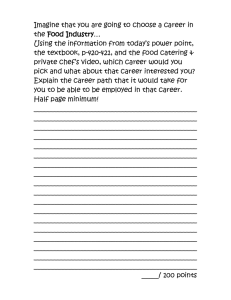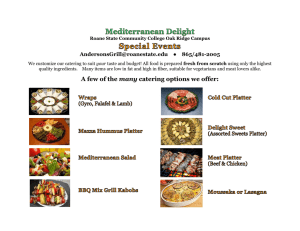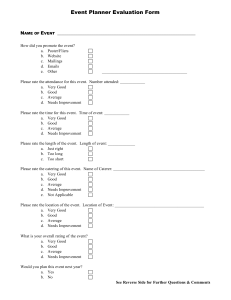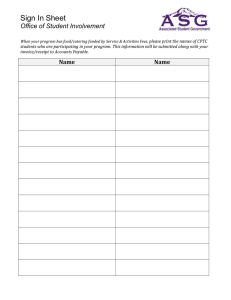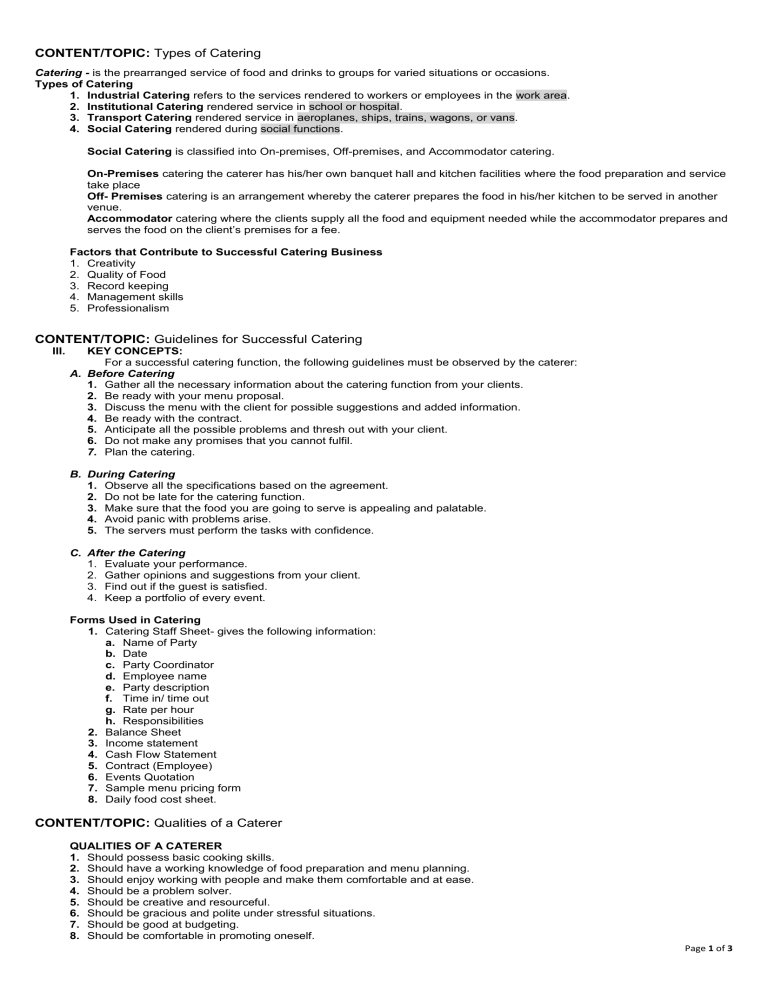
CONTENT/TOPIC: Types of Catering Catering - is the prearranged service of food and drinks to groups for varied situations or occasions. Types of Catering 1. Industrial Catering refers to the services rendered to workers or employees in the work area. 2. Institutional Catering rendered service in school or hospital. 3. Transport Catering rendered service in aeroplanes, ships, trains, wagons, or vans. 4. Social Catering rendered during social functions. Social Catering is classified into On-premises, Off-premises, and Accommodator catering. On-Premises catering the caterer has his/her own banquet hall and kitchen facilities where the food preparation and service take place Off- Premises catering is an arrangement whereby the caterer prepares the food in his/her kitchen to be served in another venue. Accommodator catering where the clients supply all the food and equipment needed while the accommodator prepares and serves the food on the client’s premises for a fee. Factors that Contribute to Successful Catering Business 1. Creativity 2. Quality of Food 3. Record keeping 4. Management skills 5. Professionalism CONTENT/TOPIC: Guidelines for Successful Catering III. KEY CONCEPTS: For a successful catering function, the following guidelines must be observed by the caterer: A. Before Catering 1. Gather all the necessary information about the catering function from your clients. 2. Be ready with your menu proposal. 3. Discuss the menu with the client for possible suggestions and added information. 4. Be ready with the contract. 5. Anticipate all the possible problems and thresh out with your client. 6. Do not make any promises that you cannot fulfil. 7. Plan the catering. B. During Catering 1. Observe all the specifications based on the agreement. 2. Do not be late for the catering function. 3. Make sure that the food you are going to serve is appealing and palatable. 4. Avoid panic with problems arise. 5. The servers must perform the tasks with confidence. C. After the Catering 1. Evaluate your performance. 2. Gather opinions and suggestions from your client. 3. Find out if the guest is satisfied. 4. Keep a portfolio of every event. Forms Used in Catering 1. Catering Staff Sheet- gives the following information: a. Name of Party b. Date c. Party Coordinator d. Employee name e. Party description f. Time in/ time out g. Rate per hour h. Responsibilities 2. Balance Sheet 3. Income statement 4. Cash Flow Statement 5. Contract (Employee) 6. Events Quotation 7. Sample menu pricing form 8. Daily food cost sheet. CONTENT/TOPIC: Qualities of a Caterer QUALITIES OF A CATERER 1. Should possess basic cooking skills. 2. Should have a working knowledge of food preparation and menu planning. 3. Should enjoy working with people and make them comfortable and at ease. 4. Should be a problem solver. 5. Should be creative and resourceful. 6. Should be gracious and polite under stressful situations. 7. Should be good at budgeting. 8. Should be comfortable in promoting oneself. Page 1 of 3 9. Should have good business sense. Factors to consider in the selection of food service workers for the catering business. 1. Should be certified to be physically healthy. 2. Should always maintain a professional and positive attitude. 3. Can write, read, and compute. 4. Should be cheerful and alert. 5. Should be always clean and neat. 6. Must be honest and trustworthy. 7. Must be dependable and responsible. CONTENT/TOPIC: Tools and Equipment in Catering Business III. KEY CONCEPTS: The tools and equipment in catering are classified into guest service and transporting equipment. A. Basic cooking equipment/ Guest service 1. Range 2. Oven 3. Steamer 4. Fryer 5. Preparation table 6. Electric Blender 7. Coffee maker 8. Kettles 9. Chaffing dish 10. Cooking pans 11. Trays 12. Soup Tureen B. Transporting tools and equipment 1. Catering box 2. Truck 3. Van 4. Trolleys C. The following are table appointments/implements for serving food used in catering: Silverware/Flatware - Dinner spoon, dinner fork, table knife, salad fork, soup spoon, dessert teaspoon. Glassware - tumbler, juice glass, champagne glass China wares/Dinnerware – dinner plates, soup plates, platters, cups and saucers, bread and plates. Table linens - tablecloth, table napkins (18-24 inches), top cloth, table sheet. CONTENT/TOPIC: Apprenticeship Training in Catering III. Key CONCEPTS: Apprenticeship is the other term for on-the-job training (OJT). OJT is a way of acquiring work practices and skills in restaurants or catering establishments. The following are some opportunities for employment that can be availed of by a student. 1. Waitering 2. Assistant cook 3. Chambermaid 4. Domestic helper 5. Salesgirl 6. Counter girl 7. Entrepreneur 8. Barmaid 9. Caterer 10. Bartender Before an applicant can become a successful employee, it is to his/her advantage if one undertakes an apprenticeship training in food service for the following reasons: 1. Increased confidence 2. Improved equipment manipulative skills 3. Improved attitude towards work. 4. Improved ability to relate with others, especially superiors and co-employees. 5. Improved productivity Places where one can apply for apprenticeship programs in food service. 1. Hotels 2. Country clubs 3. Restaurants 4. Yacht 5. Airline 6. Local market and store 7. Private catering services An apprentice who wishes to be successful in the chosen field should possess desirable personal attributes such as the following. 1. Responsible 2. Industrious 3. Patient Page 2 of 3 4. 5. 6. 7. 8. Honest Trustworthy Cheerful Punctual Neat and Clean An on-the-job trainee in food service must anticipate the following employee policies. 1. Wear clean clothes or a well-pressed uniform. 2. If hair is shoulder length, keep it always tied at the back. Wear a hairnet if directly handling food. 3. Wear minimum pieces of jewellery. 4. If possible, wear black socks and shoes. 5. Fingernails should always be short and clean. 6. Don’t smoke or chew gums while in the vicinity. 7. Eating and drinking should only be at scheduled breaks. 8. Avoid alcohol and drugs during your shift. 9. Always maintain a professional and positive attitude. 10. No employees are allowed to take any food or beverages outside the facility. CONTENT/TOPIC: Preparing/Cooking Menu I. KEY CONCEPTS: Cooking is done by exposure of food to intense heat by three methods such as conduction, convection, or radiation Conduction is the transfer of heat through direct contact from one substance to another. Example: grilling, frying, and boiling Convection Heat is spread by the movement of air, steam or liquid. Example: baking, steaming Radiation involves the transfer of energy by waves from the source of the food. Example: using a microwave oven Blanching - soaking food in a small amount of cold water, hot water, or hot oil for a short period of time. Braising - browning meat in oil, then cooking it in a small amount of liquid in a tightly covered pan, either on the stovetop or in the oven. Broiling - exposing food to direct radiant heat Frying – cooking food in an adequate amount of shortening. Poaching – prevents food from drying out by using a stock of water; with/without stirring. Pot Roasting – Cooking marinated meat with its sauce. Roasting – hot air and radiant heat. Sauteing – cooking food in a small amount of oil. Basic Cooking Process 1. The purpose of cooking meat is to make it more flavourful and tender. 2. Cooking makes fish more palatable, enhances its flavour and colour, and breaks down small numbers of connective tissues that are present. Fish only requires a short cooking time to avoid loss of moisture, flavour, and nutritive value. 3. The dry heat method can be applied to almost all types of poultry such as broiling, barbecuing, frying and toasting. 4. Vegetables should be washed before cutting and pairing and they should be cooked in a small amount of water. 5. Fruits should be washed well when eaten raw. Fruits can be baked, stewed, dried, broiled, and preserved, 6. Eggs are sources of complete protein, vitamins, iron and fat. Cooking time and temperature vary depending on the size and number of eggs. Page 3 of 3
